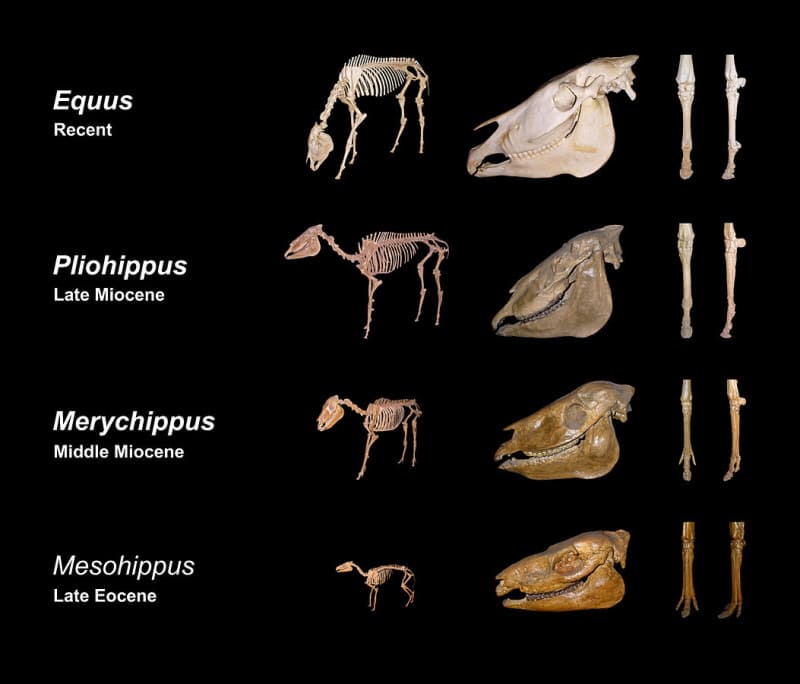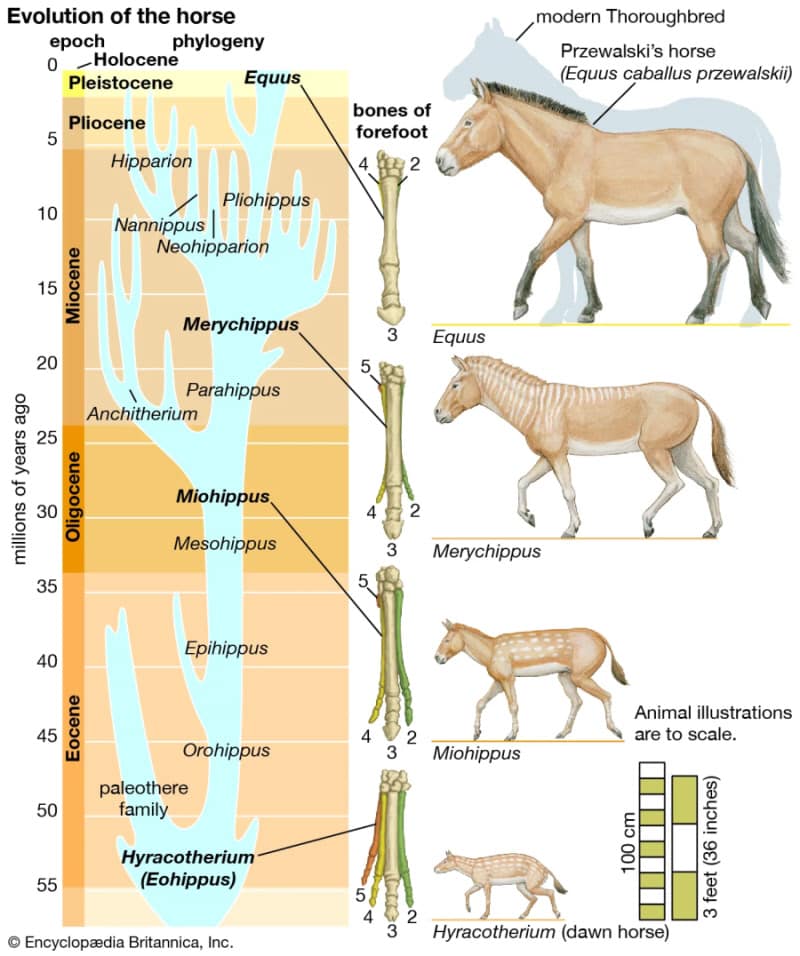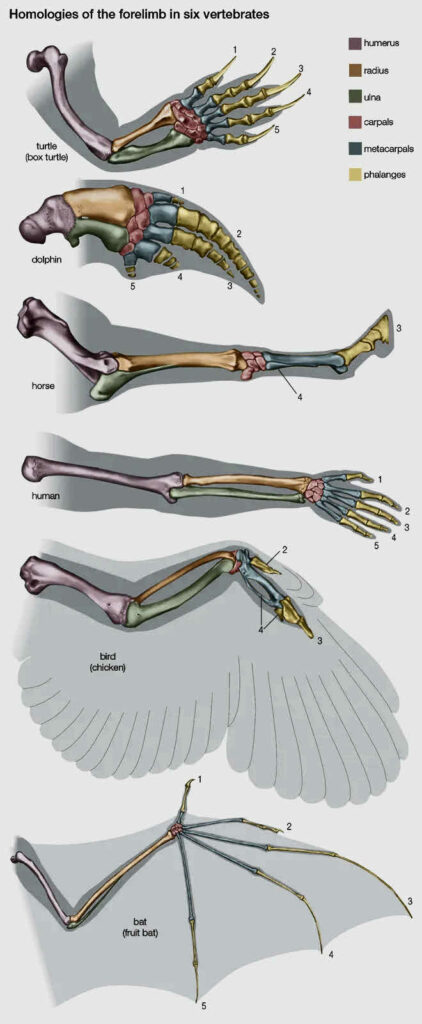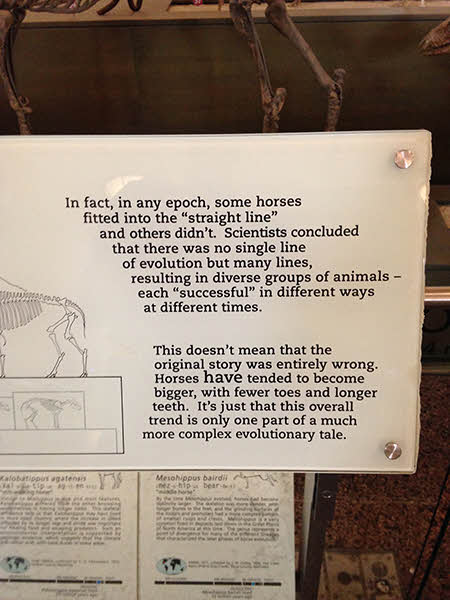Major update: 5th May 2023
How does the horse fossil record support the theory of evolution?
- It shows the variety of horses that come from an original horse-like animal.
- It does not prove the evolution from singular-celled organisms to complex creatures.
The evolution of the horse’s timeline, which is not agreed upon by the experts and keeps being altered, includes many species living at the same time and not transitioning from one type to another.
We can see how horses have changed over time, but they originated as ‘horse-like and became the numerous shapes, sizes and colours we have today.
Table of Contents:
1. The evolution of the horse is often cited as proof of evolution
The Encyclopaedia Britannica states that the fossil record, though incomplete, presents compelling evidence of evolution (accessed 4th May 2023). 1
Palaeontologists have put together a succession of forms over time that they say proves evolution:

Creation scientists do not disagree with changes, or variations, going on, but do disagree with the evolution from a simple cell to a complex creature.
Obviously, dogs can be altered in many ways and the results range from the tiny Chihuahua to the huge Irish Wolfhound.
Creation scientists believe that the wolf ancestor did propagate into many different shapes and sizes, for example, domestic dogs, wolves, foxes, coyotes, jackals, dingoes, and other dog-like mammals, but none of them changed into, for example, a horse. See: ‘Do dogs prove evolution and are Bible kinds species?‘
The Encyclopaedia Britannica gives horse evolution as compelling evidence of evolution:
The horse can be traced to an animal the size of a dog having several toes on each foot and teeth appropriate for browsing;
‘Evolution of the horse’ Britannica
this animal, called the dawn horse (genus Hyracotherium), lived more than 50 million years ago.
The most recent form, the modern horse (Equus), is much larger in size, is one-toed, and has teeth appropriate for grazing.
The transitional forms are well preserved as fossils, as are many other kinds of extinct horses that evolved in different directions and left no living descendants.”
But the experts cannot agree on the horse’s evolutionary tree.
An article below cites Bruce MacFadden, curator of vertebrate palaeontology at the University of Florida’s Florida Museum of Natural History:
The preconceived notion that the horse was once as small as a dog but progressively grew to its present stature now can be proven to be incorrect… horses diversified in size rather than just becoming larger…”
‘Ideas about fossil horses undergo evolution in thinking’ by Cathy Keen. Aug 2005. Florida Museum.
2. Is the proof for the evolution of the horse feasible?
The Encyclopaedia Britannica provides an image showing:
Numbered bones in the forefoot illustrations trace the gradual transition from a four-toed to a one-toed animal.”
Image showing ‘Evolution of the horse’ Britannica 3

The light blue on the image shows the horse’s evolution from Hyracotherium/Eohippus to Orohippus to Epihippus to Mesohippus to Miohippus to Parahippus to Merychippus and then branching to twelve different ones of which many are extinct.
One of the twelve is Equus, from which comes the horses we know today.
All this sounds very convincing and this is how the theory came about:
In 1841, the earliest so-called ‘horse’ fossil was discovered in clay around London.
‘What’s Happened to the Horse?’ by Peter Hastie 5
The scientist who unearthed it, Richard Owen, found a complete skull that looked like a fox’s head with multiple back-teeth as in hoofed animals. He called it Hyracotherium.
He saw no connection between it and the modern-day horse.
In 1874, another scientist, Kovalevsky, attempted to establish a link between this small fox-like creature, which he thought was 70 million years old, and the modern horse.
In 1879, an American fossil expert, O. C. Marsh, and famous evolutionist Thomas Huxley, collaborated for a public lecture which Huxley gave in New York.
Marsh produced a schematic diagram which attempted to show the so-called development of the front and back feet, the legs, and the teeth of the various stages of the horse.
He published his evolutionary diagram in the American Journal of Science in 1879, and it found its way into many other publications and textbooks.
The scheme hasn’t changed.
It shows a beautiful gradational sequence in ‘the evolution’ of the horse, unbroken by any abrupt changes.
This is what we see in school textbooks…”
Peter Hastie’s conclusion is that:
If it were true, you would expect to find the earliest horse fossils in the lowest rock strata. But you don’t. In fact, bones of the supposed ‘earliest’ horses have been found at or near the surface.
‘What’s Happened to the Horse?’ by Peter Hastie
Sometimes they are found right next to modern horse fossils…
The theory of horse evolution has very serious genetic problems to overcome.
How do we explain the variations in the numbers of ribs and lumbar vertebrae within the imagined evolutionary progression?
For example, the number of ribs in the supposedly ‘intermediate’ stages of the horse varies from 15 to 19 and then finally settles at 18.
The number of lumbar vertebrae also allegedly swings from six to eight and then returns to six again…”
Even Wikipedia doubts this straight-line evolutionary scenario, although the writer does assume that modern horses have evolved from Eohippus:
The original sequence of species believed to have evolved into the horse was based on fossils discovered in North America in 1879 by paleontologist Othniel Charles Marsh.
‘Evolution of the horse’ Wikipedia. 6
The sequence, from Eohippus to the modern horse (Equus), was popularized by Thomas Huxley and became one of the most widely known examples of a clear evolutionary progression.
The horse’s evolutionary lineage became a common feature of biology textbooks, and the sequence of transitional fossils was assembled by the American Museum of Natural History into an exhibit that emphasized the gradual, ‘straight-line’ evolution of the horse.
Since then, as the number of equid fossils has increased, the actual evolutionary progression from Eohippus to Equus has been discovered to be much more complex and multibranched than was initially supposed.
The straight, direct progression from the former to the latter has been replaced by a more elaborate model with numerous branches in different directions, of which the modern horse is only one of many.”
There has been no gradual change from one form to another.
Dr Niles Eldredge, curator of the American Museum of Natural History, wrote about these straight-line evolutionary, imaginary stories:
I admit that an awful lot of that has gotten into the textbooks as though it were true.
Dr Niles Eldredge, curator of the American Museum of Natural History. 7
For instance, the most famous example still on exhibit downstairs** is the exhibit on horse evolution prepared perhaps 50 years ago.
That has been presented as literal truth in textbook after textbook.
Now I think that that is lamentable …”
** =in the American Museum of Natural History.
3. Proof of Evolution in bone structure?
The Encyclopaedia Britannica shows us more fossil ‘evidence’ proving changes in evolution:
The skeletons of turtles, horses, humans, birds, and bats are strikingly similar, in spite of the different ways of life of these animals and the diversity of their environments.
‘The fossil record’ Britannica 8
The correspondence, bone by bone, can easily be seen not only in the limbs but also in every other part of the body.
From a purely practical point of view, it is incomprehensible that a turtle should swim, a horse run, a person write, and a bird or a bat fly with forelimb structures built of the same bones.
An engineer could design better limbs in each case.
But if it is accepted that all of these skeletons inherited their structures from a common ancestor and became modified only as they adapted to different ways of life, the similarity of their structures makes sense.”

To explain the image Britannica states: “Homologies of the forelimb among vertebrates, giving evidence for evolution.
The bones correspond, although they are adapted to the specific mode of life of the animal.
(Some anatomists interpret the digits in the bird’s wing as being 1, 2, and 3 rather than 2, 3, and 4.)”
Personally, I cannot accept that all of these skeletons inherit their structures from a common ancestor and that they were able to change by being modified by their environment.
I see that all these examples have in common is one designer, who wanted this similarity in these creatures.
4. Did horses evolve with a different number of toes?
Evolutionists believe that the ancestor of the horse was a five-toed, fox-sized creature called Eohippus (dawn horse), also known as Hyracotherium.
From the diagram in Encyclopaedia Britannica (section 2 above), it can be seen that evolution had to take place from five toes to three toes and then to one toe, which became the hoof.
The hoof is not just a single toe, it has been specially designed to absorb impact, provide traction, pump blood back to the heart, resist wear and fracturing, provide protection for delicate ligaments, arteries and nerves, support body weight and keep moisture throughout the hoof wall.
Just because there are similarities in design components, does not mean that they all came from one ancestor:
…all vertebrates with true limbs (amphibians, reptiles, birds, and mammals) have the same basic limb structure at least during their embryological development.
‘Vestigial Organs—Evidence for Evolution?’ by Dr. David Menton 11
This standard vertebrate limb consists of an upper limb comprising one bone, a lower limb comprising two bones, and a hand or foot bearing five digits (fingers and toes).
Thus, the limbs of all limbed vertebrates share fundamental similarities, with each being specialized to meet the needs of each species.
Horses have five digits while developing as an embryo, but generally all but one (the third digit) is absorbed before birth.
Vestiges of the second and third metacarpal (and metatarsal) bones are visible in the modern horse as the splint bones.
Some fossil horses, however, had three toes, but both three-toed and one-toed horses have been found together in the fossil record.
In National Geographic magazine, for example, there is a picture of the feet of both a three-toed horse (Pliohippus) and a one-toed horse (Equus) that were found at the same volcanic site in Nebraska.” 10
Any thought that the splint bones in horses are redundant toes is completely wrong because they form an important part of the overall design of the leg:
Hailed as ‘vestigial’ or useless leftovers of evolution, splint bones actually are far from useless bits of bone.
‘What About Horse Toe Evolution?’ by Rebekah L. Holt. 12
Splints are two icicle-shaped bones found on the back of each leg.
They support the carpal joints (front knee) on either side of the cannon bone, and the tarsal (or hock) joints on the rear leg.
In addition to assisting weight support, splints form a vital ‘groove’ and protection for ligaments and tendons that enable equine locomotion.”
Horses have indeed had variations, as can be seen from miniature ponies, Shires, Icelandic, Konik, etc, and then there are the other species very similar to horses:
- ass or donkey, Equus asinus;
- mountain zebra, Equus zebra;
- plains zebra, Equus quagga;
- Grévy’s Zebra, Equus grevyi;
- kiang, Equus kiang;
- onager, Equus hemionus.
5. What do horse fossils actually prove?
Hyracotherium/Eohippus and Orohippus do for instance appear in the fossil record at the same time as Epihippus. [These three are the oldest known horses]
‘The evolution of the horse’ by Mats Molén 13
Mesohippus and Miohippus appear together with Merychippus and Parahippus.
Almost all other horses (with a possible exception of one or two)—Parahippus, Merychippus, Pliohippus, Equus and possibly also Miohippus—are represented at the same time during much of the period when they have been found as fossils.
(But especially in the newer evolutionary schemes, different names have been given to very similar animals, giving the appearance of evolution as well as providing fame to their discoverers; see examples in Froehlich 20029 and MacFadden 20054).
Fossils of Hyracotherium have also been found very high up in the strata (Pliocene), but these findings have been rejected as reworked (i.e. eroded and deposited at a later strata) in spite of the fact that the geological observations do not show any signs of disturbance.
Thus, the fact that most of the horses lived almost at the same time undermines their proposed evolution.”
Here is a visualisation of this so-called direct line of evolution with the horses shown in group ‘A’ being the oldest in history.
The information was taken from: ThePaleobiology Database ‘Revealing the history of life’ 14
‘Eohippus’ is now a junior synonym of ‘Hyracotherium’ 15

I started detailed research on horse-like animals but I’ve discovered that the experts can’t agree on the ancestral tree and it keeps changing and new types are being added and existing ones changed.
It’s a mess!
Kyle Butt has reported that the Natural History Museum now admits that the ‘evidence’ once used to teach horse evolution has been proven to be inaccurate in a new horse ‘evolution’ exhibit:
they [the Natural History Museum] admitted that ‘evidence’ for horse evolution that was used in the past was wrong, but then they just presented more wrong information.
‘Horse Evolution: Wrong Again!’ by Kyle Butt, M.Div. 16
The placard at the exhibit says,
‘Scientists concluded that there was no single line of evolution.’
That means the material that showed horse evolution as a ‘single line’ is all false. Then they stated,
‘This doesn’t mean that the original story was entirely wrong.’
Actually, the story of horse evolution that is presented in the old textbooks as well as the new exhibit is all wrong.
Horses never evolved from a different kind of animal.”

The classification is ever-changing with ongoing renaming, so it has become a nightmare to unravel, as the quote below shows:
It would probably be possible to classify the different parts of Parahippus as belonging to two different animals—Miohippus and Merychippus.
‘The evolution of the horse’ by Mats Molén
This latter result can also be inferred by the work of Cavanaugh et al., as Parahippus showed similarities to 14 of 18 species of horses.
Therefore, the ‘Parahippus’ step in the horse series appears to be a mixed up group of unrelated fossils.”
Mats Molén concludes from a Creation science perspective:
that the horse series probably comprise three different created kinds, not including all animals that have been labelled Hyracotherium.
‘The evolution of the horse’ by Mats Molén 17
Hyracotherium itself appears to contain several different created kinds such as animals similar to tapirs.”
Creationists believe that within ‘kinds’ there can be changes – just think how varied dogs are in their looks, but they are still all dogs, and they, in turn, are very close to wolves, foxes, coyotes, jackals, etc.
So with the Hyracotherium ‘horse’ group, there could be three or more original kinds that were created by God.
The Big Bang theory suggests that everything started with a massive explosion and from then on everything evolved, but are scientists always right?
But there are many problems with this thought, even within the scientific community itself, see how evolutionists’ arguments don’t add up in anatomy, molecular homology, biogeography, fossils, etc.
See Creation and Evolution – Conclusive evidence for the age of the universe.
6. There appear to be no gradual changes between fossils
Yes, bone structure can have similar parts, but I would say that is because the Designer has decided to use similar ‘building blocks’.
The image of the different bone structures above shows similarities but it does not show evolution, no gradual changes from an arm gradually evolving into a wing.
Creationists believe that changes happen, but within their ‘kinds’, so a mouse cannot grow wings, etc.
The fossil record can show change, but not an evolution from the simplest cell to complex creatures.
Creation scientists believe that any changes are within their ‘kind’.
The Bible tells us:
And God said, ‘Let the water teem with living creatures, and let birds fly above the earth across the vault of the sky.’
Genesis 1:20-21 NIV
So God created the great creatures of the sea and every living thing with which the water teems and that moves about in it, according to their kinds, and every winged bird according to its kind.”
I would suggest that all these kinds were created to be unique and only within these kinds can things change and evolve.
Before the time of Charles Darwin, a false idea had crept into the church—the belief in the ‘fixity’ or ‘immutability’ of species.
‘Speciation’ Answers in Genesis 18
According to this view, each species was created in precisely the same form that we find it today.
The Bible nowhere teaches that species are fixed and unchanging…
While biologists debate what constitutes a species, the Bible alludes to a much broader category, called a ‘kind.’
The biblical kind often includes many different species, but they still belong to the same family….
Evolutionists seek to explain the origin of species from a single, hypothetical, primordial life-form by means of progressive change and natural selection.
When God created the kinds, He frontloaded them with genetic differences—with the potential to form all sorts of new species and varieties.”
So the ancestors of the horse do not prove evolution from simple-celled organisms to complex creatures.
7. Frequently asked questions (FAQ)
What did the horse evolve from?
Evolutionists theorize that Hyracotherium, also known as Eohippus, a fox-sized animal was the horses’ ancestor.
The scientific world is in turmoil about the lineage of the horse.
Creation scientists believe that horses and probably donkeys, zebra, kiang and Onager come from one common ancestor that God created as an original ‘kind’.
There is the thrill of how this world is constructed including all the physical laws of the universe, but many scientists don’t seem to ask how these ‘laws’ arose.
There are scientists who believe in God and also in the creation account in Genesis.
How has sexual reproduction evolved – scientists can’t explain it.
Why is childbirth so painful within humans, surely if evolution were true this would have evolved into a less painful event?
It’s amazing to think of something so far away as the Pole Star, Polaris, is able to give us the right direction on the Earth, but there is a big discrepancy in the distance of Polaris from the Earth.
References – open in new tabs:
‘Evolution of the horse’ Encyclopedia Britannica. ↩
‘Equine_evolution’ H. Zell (User:Llez), CC BY-SA 3.0, via Wikimedia Commons ↩
‘Evolution of the horse’ Access Date: May 4, 2023. Encyclopædia Britannica ↩
‘Evolution of the horse’ Wikipedia. Accessed: 24th April 2023. ↩
Niles Eldredge, as quoted in: Luther D. Sunderland, ‘Darwin’s Enigma: Fossils and Other Problems’, fourth edition [revised and expanded], Master Book Publishers, Santee [California], 1988, p. 78. ↩
M.R. Voorhies, ‘Ancient Ashfall Creates a Pompeii of Prehistoric Animals,’ National Geographic, January 1981, p. 74. ↩
‘Vestigial Organs—Evidence for Evolution?’ by Dr. David Menton on July 7, 2014. Answers in Genesis ↩
‘What About Horse Toe Evolution?’ by Rebekah L. Holt. 25 July 2008. Creation Ministries International ↩

